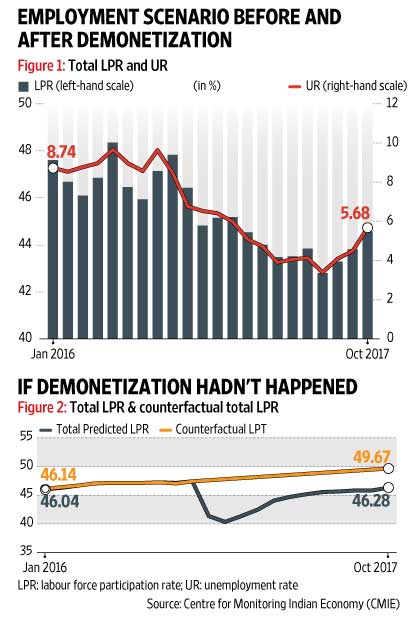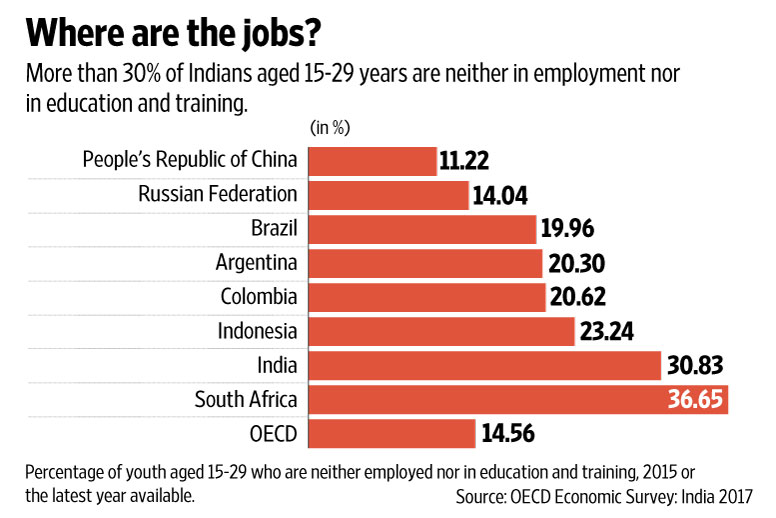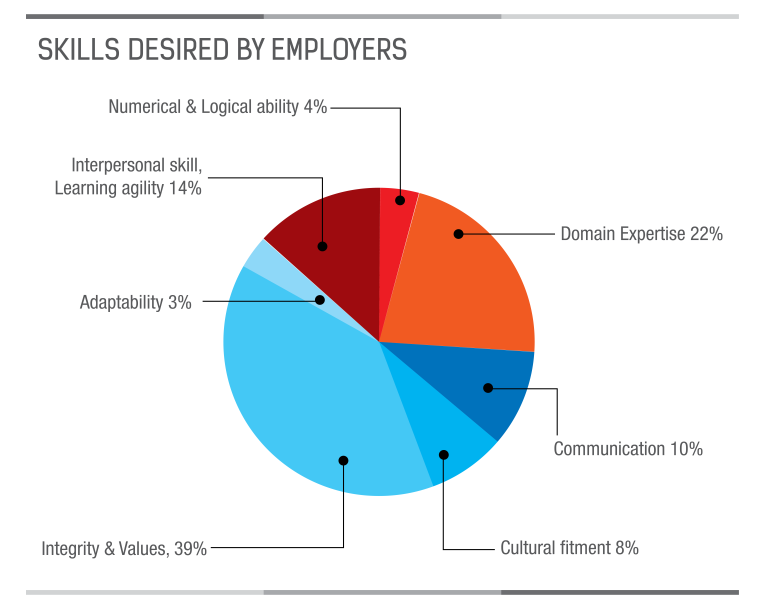Training Vs Education: What Holds The Key To Employment In India?
Unemployment is on the rise in India which is forcing is to introspect what is more important for employment, training or education?

India, a country of over 1.2 billion people, have many issues to tackle on a daily basis. Some of the worrying problems at hand include poverty, corruption, population control, sanitation and many more. The government spend billions of rupees every year, and some of the brightest minds of the country work tirelessly to eradicate these problems.
One major issue which has been plaguing India for the longest time is the problem of Unemployment. It is quite perplexing to see the consistent rise in the rate of unemployment in a country which is among the fastest growing economies in the world.
A higher unemployment rate brings far bigger problems than just unemployed individuals. The higher the unemployment rate, the slower the economy grows. As a result of which there is a reduction in the total spending power of the country. This makes the unemployed households vulnerable to economic shocks, such as the Great Recession, which began in December 2007.
The impact of the great recession may not have been too strong in India but there is no guarantee that it will be the same come the next economic shock. Under such circumstances, the increasing unemployment may prove to be a bigger burden than the present.
Contents [hide]
(Un)Employment In India

In its fifth year, the annual Employment- Unemployment Survey (EUS) by Labour Ministry, the Government of India revealed some very shocking numbers. In a sample of 1,56,563 households spanning across the country, the unemployment rate reached 5%, the highest in the past five years.
The sample size was taken of people aged 15 and above. As the above image depicts, the unemployment rate in 2011-2012 was 3.8%, which increased to 4.7% and 4.9% in 2012-2013 and 2013-2014 respectively. No survey was conducted in 2014-2015, which made this survey a crucial one, citing the new government. But apart from the names of the ministers changing no good news was brought to the nation.

Demonetization was planned to uplift the digital dream and curb the use of cash in the Indian Economy, bringing it to a minimum if not removing it entirely. In one of the most unexpected scenarios, demonetization hit the employed sector with one of the worst blows imaginable.
Demonetization hit millions of jobs, not only declining the employment rate but also declining the labour force participation rate, which simply meant that persons started dropping out of the labour force. However, the clouds scattered after 10 months and the LPR started increasing again, but so did the unemployment rate.
Why Does India Face Unemployment?
The grim unemployment situation in India is not new, but it has been reaching embarrassing lows of late. The cause of unemployment in the Indian society is multi-faceted. The prompt population growth is one of them, which can be termed as the biggest cause of unemployment in rural India. Although the Government of India is providing many low job opportunities for people in the rural areas, they are turning out to be insufficient due to the continuous increase in the population size.
Secondly, the land usage has not been kept at par with the outburst of employment need of the country. In rural India, a large chunk of the population still depends directly on the land for their livelihood. This is causing unemployment as the population is increasing but the land is constant.
Last but certainly not the least, the education and the skills of the people can be collectively blamed for the high unemployment levels. The standard of education in the country has not moved over classrooms and can be considered a gateway to acquire certificates rather than skills. In the heaps of countless engineers and marketing graduates, a skilled workforce is still a distant dream.

As per the economic survey of Organisation for Economic Co-Operation and Development (OECD), over 30% of Indians between the ages of 15 and 29 are neither in education or skill training nor in employment. In simpler terms, organizations are looking for a skilled workforce and not just workforce. Gone are the days when manpower was the term, today it is known as skilled manpower.
Skill India: Is It The Correct Path?
Skill India, the brainchild of Prime Minister Narendra Modi is a campaign launched in 2015. The campaign’s main aim is to train over 400 million people in India in different skills by 2022. The Skill India campaign includes multiple initiatives from the government which can carry forward the vision. These initiatives include “National Skill Development Mission”, “Pradhan Mantri Kaushal Vikas Yojna” and “Skill Loan Scheme”. The Skill India campaign received both acclaim and criticism, but it did not go unnoticed.
It can be said that due to these initiatives many top companies in the world have come forward and invested in India which can aid in tackling the issues related to unemployment. Oracle in early 2016 announced that it would build its second largest campus in Bengaluru, which will span over 2.8 million sq. ft.
Oracle Academy also stated that they would launch initiatives to train more than half-a-million students each year. In the 2017-2018 budget, GOI decided to set aside Rs 17,000 crore, the biggest allocation to the sector which will directly boost the Skill India Mission. By 15 February 2016, the “Indian Leather Development Programme” had trained over 50,000 individuals in a span of 100 days and it plans to train almost 1.5 lakh individuals annually.

In India, around 40% of the workforce is illiterate, while another 40% consists of school dropouts, a study by the Boston Consulting Group revealed. Only 10% of the workforce is vocationally trained and graduates. Initiatives such as Skill India can help create a skilled workforce in the short run, but as the population increases and the need for skilled workers skyrockets, these campaigns can fall well-short. In a country where 80% workforce has not completed a significant level of education, the solution is visible, but far. To overcome the unskilled workforce concern, educational reforms are required. Impacting the minds of students at the foundation level is the biggest reform that can be brought in this domain, and probably the country.
Improving The System In The Education System
In the past decade and a half, the Government of India has invested substantially in the primary education of the children of the country. This number is expected to grow as we move along, but is it being implemented correctly? Right from the start, students are taught to cram and produce rather than learn and remember.
The current education system can be termed as nothing but a way to achieve certificates that make you eligible for applying for jobs or higher degrees. ‘Eligible’ and ‘Skilled’ are two very distant terms which are not taught to students in the current education system of the country.
In the Annual Status of Education Report (ASER) of 2006, only 53% of children of standard 5 could read a standard 2 texts. After 8 years, one would hope to see a difference citing the high expenditure on education. But in 2014 ASER, the number of children of standard 5 who could read a standard 2 texts dropped to 48%.
There are countless answers to the question, ‘What can be done to improve our education system?’ To begin with, it is important to look away from the concept of learning to write and move to learning to learn. It is imperative for us to understand that there is a learning environment outside of books as well and it should be the primary source of learning.
Secondly, acquiring skills should be as rewarding as learning from books. A person who is proficient in a programming language without a degree should be given the same amount of respect as a degree holder is given.
Finally, the need for training for teachers has risen substantially. Teachers should be taught how to teach students effectively and help them find and nourish their skills for the future.
Start-ups That Are Putting Skills Into Skilled Workforce
Just 2% of India’s huge workforce is skilled, while the number reaches 68% in the UK and 74% in Germany. The need for a skilled workforce in the country has been recognized by many start-ups who have managed to get in the field and work towards taking the number of skilled workers in the country higher.
One such venture is UpSkill, which trains unskilled individuals to make them job-ready and then helps them get employed. A crowdfunded platform, UpSkill is helping individuals in all aspects of employment. Care24, another such platform is training unskilled professionals in the unorganized health sector to help them secure better employment opportunities.
Start-ups like Care 24, Hackr.io and UpSkill along with campaigns like Skill India are working hard to take India higher on the list of the countries with a skilled workforce. Even though we are still a long way from a good number, somewhere, someone must begin.
But in the end, the building can only be strong as its foundation. Until strong educational reforms are introduced in the country, the door to jobs will be locked. Innovation in the educational sector and effective training modules together hold the key to jobs in India.
About the Author: This article is contributed by Saurabh Hooda – Founder at Hackr.io.

OK, YOU’VE minced words, let ME put it Clearly – the Education System in India is made BY and FOR – ANIMALS!
SKill India is a big circus . Government and Politicians don’t know what to do . And people they want to become mangers only .